Pro iDSD
The PCB Tour - part 1/2
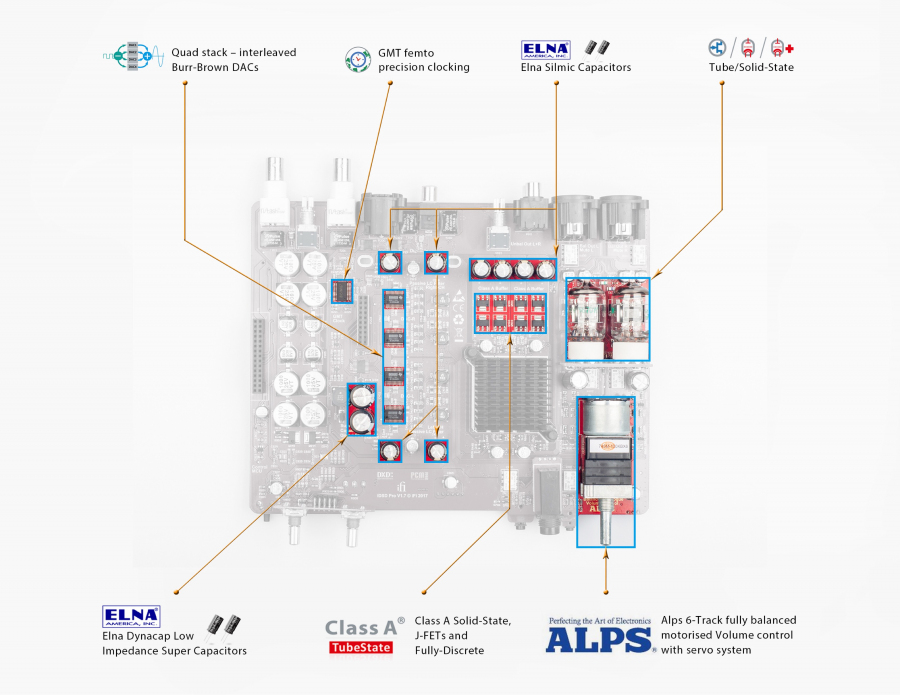 1. Quad stack – interleaved Burr-Brown DACs
1. Quad stack – interleaved Burr-Brown DACs
The iDSD Pro uses a Quad ‘stack’ of iFi’s Bit-Perfect DSD and DXD DACs by Burr-Brown in a custom ‘interleaved’ configuration. This enables a total of eight pairs of differential signals to be used and mixed – four pairs of signals per channel.
All signals to the DACs are re-clocked with the low-jitter Global Master Timing® master clock derived from the AMR DP-777 DAC.
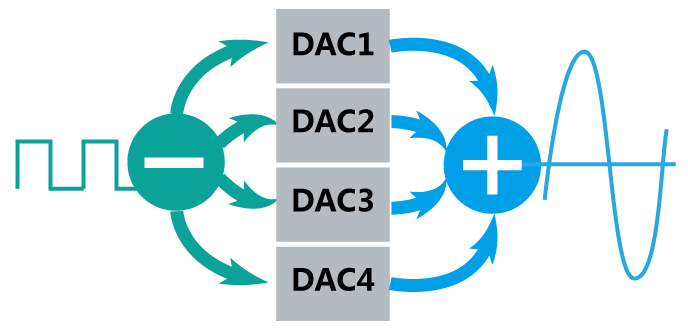
The DACs operate ‘Voltage Output Mode,’ giving >119dB dynamic range. All filtering is passive, using a fully-balanced third order capacitor/inductor/capacitor filter, rather than active, feedback-based circuits, to remove ultrasonic noise. (Active filters struggle with the amount of ultrasonic noise and RFI they have to handle and at a few 100kHz they can lose the ability to filter noise at all, which is precisely where a lot of noise is present.)
Using passive CLC filtering directly after the DAC means that the following analogue stage is not required to handle ultrasonic noise and RFI originating from the DAC process.
2. Femto Precision GMT Clock & Reclocker
For all inputs data is sent to the aforementioned Memory Buffer, which iFi describes as ‘large’ and ‘elastic’. Here it is de-jittered to eliminate any transmission of source jitter to the DAC output. The data from the Memory Buffer is further re-clocked by with the low-jitter Global Master Timing® clock, which also drives the X-Core 200 & FPGA.

Click on this more information on iFi’s jitter solution:
http://www.amr-audio.co.uk/html/dp777_tech-papers_jitter.html
External Clock options and Synchronisation
For synchronization in recording studios the iDSD Pro supports AES3id based DARS (Digital Audio Reference Signal) as recommended in the Audio Egineering Society’s published AES11 standard. And if you happen to have a really good atomic clock (at least a Sanford Research Systems PERF10 should be used) this can be used as to further elevate the iDSD Pro over the internal clock system.
3. Tube/Solid-State
Compared to high-end headphone amplifiers, the tube stage of the Pro iDSD is different in two-ways. First, we don’t use good-quality 6922s or similar. Instead we use the very best; General Electric 5670 which is the premium variant with a different pinout.
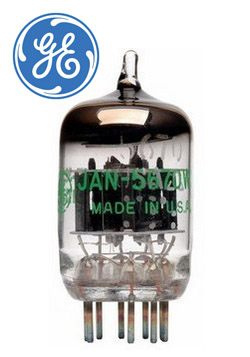
Second and just as important is the circuit design. Unlike other amplifiers that have the same circuit and just switch in/out the tube section, the Pro iDSD is the very first of its kind that has two individual input circuits – one tube and one Solid-State. This results in the best sonics of both worlds because the signal path is the shortest and there is no compromise to ‘shoe horn’ the tubes into an already existing solid-state circuit.
For the first time, one can enjoy both the sound of Solid-State and Tubes in a single package (rather than as an ‘Effect Type’ add-on within an otherwise conventional solid-state design) and be able to switch in real-time. For some recordings and headphones/loudspeakers, Solid-State may sound ‘more lively.’ For others, Tube and Tube+ (especially Tube+) will sound more ‘luxurious.’ Select the one that sounds best for that particular moment, be it the recording, the mood or even the weather. After all, enjoying music is an experience to be savoured and not a scientific research exercise.

We haven’t stopped there. We are tube lovers and we appreciate sometimes there is a need for even more tube-like sound, there are two tube settings – Tube and Tube+. The Tube+ position reduces overall loop-gain and thus negative feedback to the minimum. This gives a different trade-off between the tube’s natural harmonics and the transient performance.
Western Electric with their own premium version of 6922
First introduced by Western Electric in 1946 with the WE396A, from the 1950s onwards (and for the next 30 years thereafter) General Electric (and several other tube/valve manufacturers) followed Western Electric with their own premium version of 6922. This range had controlled warm-up and tight specifications on grid-current, noise and microphony. The result, significantly smoother and more organic sound qualities.
4. Class A Solid-State, J-FETs and Fully-Discrete
The Solid-State amplification section of the Pro iDSD is just as seriously executed as the Tube amplification section. It is the on the lines of the Pro iCAN.

The amplifer audio circuit is a development of iFi’s revolutionary ‘TubeState’ design. It is fully discrete, fully-balanced with either tube or J-FET input switchable, bipolar second stage and MOSFET-buffered bipolar class A Power stage. The resulting circuit may be best described as a ‘tri-brid’ where each device is used to greatest sonic advantage while minimising any drawbacks. Furthermore, the circuit is pure DC coupled to avoid using any sonically-degrading coupling capacitors. All of these are far from ‘run of the mill.’
5. Alps 6-Track fully balanced motorised Volume control with servo system
The Pro iDSD has a premium Japan Alps motorised rotary volume potentiometer. This is the ‘6-Track’ version with 4 tracks used for a true balanced volume control. This is the litmus test for any amplifier to see if it is truly balanced or operates internally in single-ended mode. Those using ‘2-Track’ volume controls may offer balanced in and out but are not true balanced designs. The Pro iDSD however is fully-balanced from beginning to end. Just like its sibling the Pro iCAN.
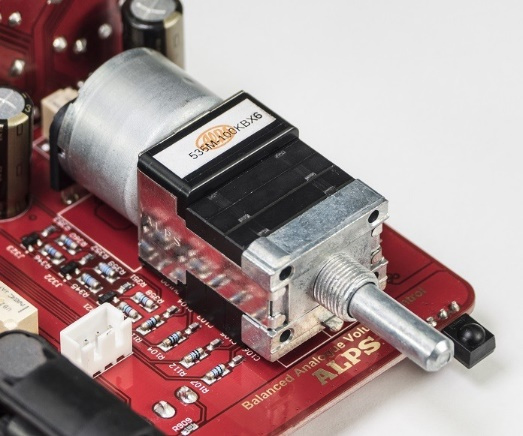 6. Elna Silmic Capacitors
6. Elna Silmic Capacitors
To maximise dynamic performance, especially with bass, the analogue stage is backed by audio-grade ELNA Silmic Capacitors located within a few millimetres of the audio circuitry supplied. Elna Silmics are used in the final stages of the main DC bus which is filtered using multiple stages of inductor/capacitor filters.
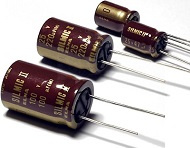
To boot, Elna Silmics are usually only found in components that cost far more as they considered ‘boutique’ components yet we consider them a ‘must have’ to achieve the best sound quality. We hope that it is apparent that the Pro DSD has the best parts in the right sections to carry out the best job possible.
7. Elna Dynacap Low Impedance Super Capacitors
The digital section is powered by a bank of Elna Dynacaps ‘Super Capacitors’ totaling 6.6 Farad (6,600,000uF). iFi uses Elna Dynacap DZ (TM) Super capacitors because they have 400 times lower internal impedance than common grades of super capacitors. This exceptional low impedance means they release energy much faster than other super capacitors.
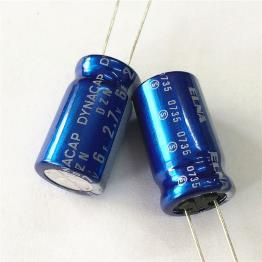 8. Power Supplies
8. Power Supplies
Using classic tube design, brought up-to-date with 21st Century technology, all incoming DC is converted to a high-frequency waveform then rectified and filtered by a choke input capacitor filter. This produces a first-level DC bus from which all further voltages are derived. The circuit also generates a galvanically-isolated power supply voltage for the USB input circuitry.
The digital section is powered by a bank of Super Capacitors totaling 6.6 Farad (6,600,000uF). iFi uses Elna Dynacap DZ (TM) Super capacitors because they have a 400 times lower internal impedance than common grades of super capacitors.
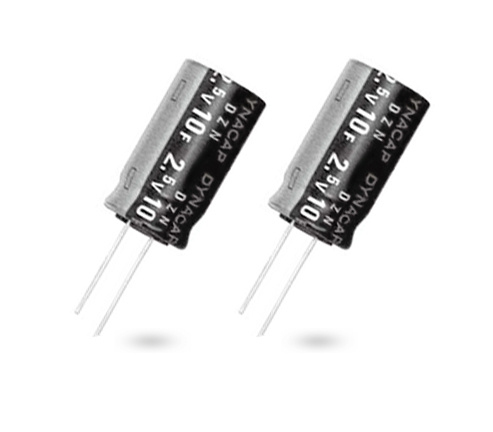
Individual low-noise TI LDO Regulators with local LC filtering provide the final low-noise power for all individual digital sections, a total of six individual regulators cover Clock, SPDIF Input and the DAC’s digital section.
For the analogue stage (especially the tubes) higher voltages are needed. The whole stage effectively operates on a 60V rail offering massive potential dynamic range.
STAY TUNED, THERE'S MORE!



































